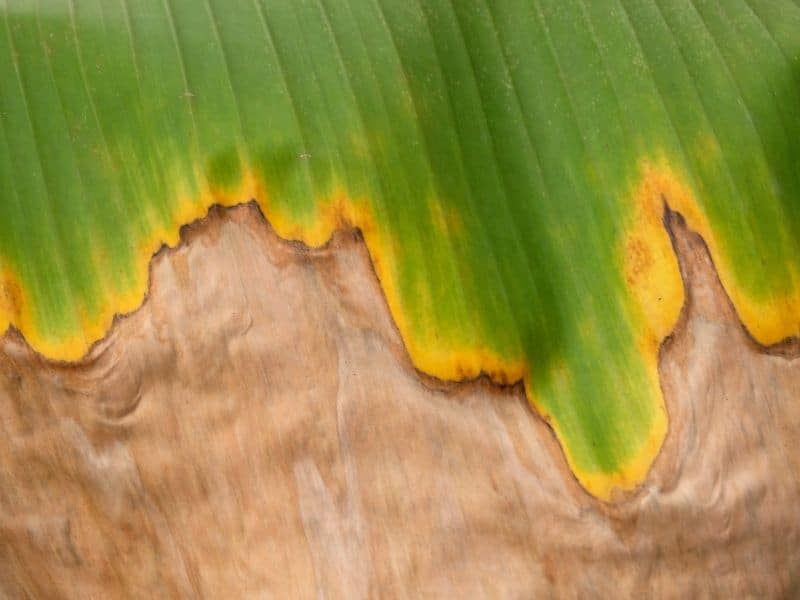Banish brown spots on your Dwarf Banana leaves with our expert care and treatment guide!
As a proud banana tree owner, waking up to find those dreaded brown spots speckled across your plant’s leaves can be disheartening. But before you despair, know that brown spots on banana leaves are common and often treatable. Understanding the causes and implementing a strategic response can help restore your tree’s bright green glow
Common Causes of Brown Banana Leaf Spots
Brown spots on banana trees typically stem from one of three underlying issues:
Fungal or Bacterial Infections
Two common culprits are fungal infections like Fusarium wilt or Anthracnose and bacterial invaders like Banana Xanthomonas Wilt (BXW). These pathogens manifest as brown or black spots, sometimes surrounded by yellowing halos. Lesions can appear water-soaked or sunken.
Environmental Stress
Factors like too much sun, poor drainage, under/overwatering, and temperature swings can all stress plants. Bananas react by developing scattered brown spotting, crispy edges, or large necrotic patches on leaves.
Pest Damage
Insects attacking plant tissues can leave behind telltale trails of brown blemishes. Aphids, thrips, and spider mites are frequent offenders. Webbing, honeydew, or visible pests confirm bugs are the culprit.
Diagnosing the Cause of Brown Spots
Accurately diagnosing the trigger for those pesky spots is crucial for effective treatment.
Assess Spot Patterns and Appearance
Fungal spots display dark edges and concentric rings, Bacterial lesions are often uniform in coloration, Environmental stress induces random distributed spotting Trails or clusters point to pests,
Check Leaf Undersides
Pests like spider mites congregate on the undersides of leaves. Their presence confirms bugs, not disease, are likely responsible for spots.
Review Cultural Conditions
Overwatering, poor drainage, extreme temperatures, or inadequate fertilization can manifest as leaf spotting. Evaluating cultural practices helps identify environmental stress factors.
Isolate Affected Plants
Quarantine spotted plants from healthy ones to prevent disease spread. Fungal, bacterial, and pest causes can all be contagious to surrounding vegetation.
Send Leaf Samples for Lab Testing
When the trigger remains elusive, plant labs can definitively diagnose fungal, bacterial, or viral pathogens through culturing, molecular testing, and microscopy.
Effective Treatments for Banana Leaf Spots
Once the cause is clear, implement targeted treatment:
Fungicides
After pruning infected leaves, spray neem oil or copper-based products. Improve airflow and drainage. Remove all diseased debris to prevent spore spread.
Bactericides
No true bactericides exist, but copper compounds inhibit bacterial growth. Improve sanitation by disinfecting tools and removing infected plant matter promptly.
Pest Control
Insecticidal soaps, horticultural oils, and neem treatments can eliminate mites, thrips, and other pests. Sticky traps monitor populations. Remove badly infested leaves.
Reduced Watering
If overwatering caused spots, allow soil to partially dry out between waterings. Improve drainage with amendments or planting on a slope.
Shade
Filter sunlight with shade cloth if intense light damaged leaves. Gradually acclimate to stronger light.
Stable Conditions
Eliminate or reduce temperature swings and drafts. Move potted plants indoors temporarily if necessary.
Prevention Is the Best Medicine
While treatment can resolve existing leaf spots, prevention is key to protect banana trees long-term:
Ensure Proper Conditions
Provide appropriate sunlight, spacing, water, drainage, airflow, humidity, and temperatures to minimize plant stress.
Apply Protective Fungicides
Use neem oil or other organic fungicides to deter fungal spores from infecting leaves, even before spots develop.
Fertilize and Mulch
Boost plant health with regular fertilizer applications. Mulch retains moisture while suppressing weeds and pests.
Monitor for Pests
Inspect both leaf surfaces at least weekly for early signs of mites, thrips, or other pests. Take action before populations explode.
Prune Strategically
Remove older, lower leaves and dense growth to encourage circulation. Promptly discard any spotted foliage.
Disinfect Tools
Clean pruning shears, spades, and other tools with bleach solution between plants to avoid spreading disease.
Isolate New Plants
Quarantine new acquisitions for a few weeks to prevent introduction of pathogens from nurseries.
By understanding the most common causes of those frustrating brown spots, diagnosing the trigger, taking prompt action, and focusing on prevention, you can keep your banana tree’s leaves vibrant, green, and beautiful. Don’t allow mysterious spots to detract from the tropical flair of your indoor or outdoor banana plants.
Recognizing Stress Signs
When brown spots pop up, its your Dwarf Banana waving a flag, signaling distress. Theyre not just blemishes; theyre a plants version of an SOS. Keep an eye out for spots where leaves are curling or falling off. This means your plant is more than just stressed; it’s in crisis mode.
Distinguishing Between Fungi and Bacteria
Its a detective game when distinguishing between fungal and bacterial brown spots. Spots caused by fungi come in many sizes and shapes, and some of them have a red or yellow edge that makes them look like they’re trying to be trendy. Bacterial spots? Theyre more straightforward, often uniform in their water-soaked look. Don’t be fooled, though. If the conditions are right, both can spread faster than a meme. Fungi spread spores, and bacteria can ride on water droplets or your hands.
Taking care of fungus on a banana tree.
FAQ
How do you treat banana leaf spot disease?
|
Product Name
|
Technical Content
|
Dosage
|
|
Indofil M45 Fungicide or
|
Mancozeb 75% WP
|
0.8 – 1.1 gm/lit water
|
|
Dithane 45 Fungicide
|
|
2 – 2.5 gm/lit water
|
|
Blitox Fungicide or
|
Copper Oxychloride 50 % WP
|
1 – 2 gm/lit water
|
|
Blue Copper Fungicide
|
|
|
- The Ultimate Guide to Growing Strawberries in Raised Beds - August 8, 2025
- No-Dig Garden Beds: The Easiest Way to Grow a Beautiful Garden - August 6, 2025
- How to Protect and Preserve Wood for Raised Garden Beds - August 6, 2025


